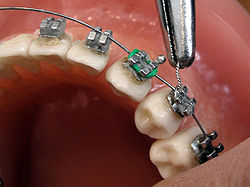Orthodontics
 |
|
| Occupation | |
|---|---|
| Names | Orthodontist |
|
Occupation type
|
Specialty |
|
Activity sectors
|
Dentistry |
| Description | |
|
Education required
|
Dental degree |
Orthodontia, also known as orthodontics and dentofacial orthopedics, is a specialty field of dentistry. An orthodontist is a specialist who has undergone special training in a dental school or college after they have graduated in dentistry. It was established by the efforts of pioneering orthodontists such as Edward Angle and Norman William Kingsley. The specialty deals primarily with the diagnosis, prevention and correction of malpositioned teeth and the jaws.
"Orthodontics" is derived from the Greek orthos ("correct", "straight") and -odont- ("tooth").
The history of orthodontics has been intimately linked with the history of dentistry for more than 2000 years. Dentistry had its origins as a part of medicine. According to the American Association of Orthodontists, archaeologists have discovered mummified ancients with metal bands wrapped around individual teeth. Malocclusion is not a disease, but abnormal alignment of the teeth and the way the upper and lower teeth fit together. The prevalence of malocclusion varies, but using orthodontic treatment indices, which categorize malocclusions in terms of severity, it can be said that nearly 30% of the population present with malocclusions severe enough to benefit from orthodontic treatment.
Orthodontic treatment can focus on dental displacement only, or deal with the control and modification of facial growth. In the latter case it is better defined as "dentofacial orthopedics". In severe malocclusions that can be a part of craniofacial abnormality , management often requires a combination of orthodontics with headgear or reverse pull facemask and / or jaw surgery or orthognathic surgery.
This often requires additional training, in addition to the formal three-year specialty training. For instance, in the United States, orthodontists get at least another year of training in a form of fellowship, the so-called 'Craniofacial Orthodontics', to receive additional training in the orthodontic management of craniofacial anomalies.
For comprehensive orthodontic treatment, metal wires are inserted into orthodontic brackets (braces), which can be made from stainless steel or a more aesthetic ceramic material. The wires interact with the brackets to move teeth into the desired positions. Invisalign or other aligner trays consist of clear plastic trays that move teeth. Functional appliances are often used to redirect jaw growth.
...
Wikipedia
